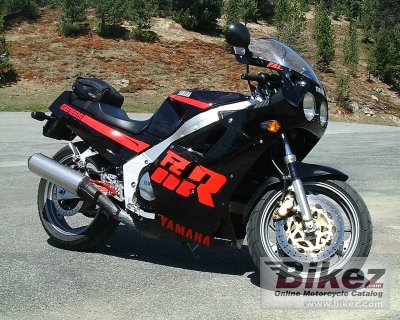



It wasn't until 1987 that Yamaha ventured into the Superbike class. Suzuki, Honda and Kawasaki had all entered the Superbike arena with their GS X-R750, VF1000R and GPz1100 respectively. However, Yamaha's entry into the big bike arena was worth the wait.
Yamaha referred to the FZR 1000 as the "ultimate road machine" which many people considered to be the usual marketing hype with a lot of style but perhaps a lack of substance.
This proved not to be the case. It seems that what Yamaha had done, rather cleverly, was to take a keen interest in the innovation and developments of other motorcycle manufacturers as they attempted to climb the Superbike mountain, and then take all the best bits and mix them into one new bike.
This meant that in many ways the FZR1000 was nothing new, a naturally world-class beating machine created by simply using everyone else's ingenuity.
For example, the engine was in effect an FZ750 lump, bored out to 989cc. It was a 20 valve in-line four developing 125bhp at 10,000rpm. However, this meant that it matched Suzuki's GSX-R1100 in terms of power, but the five valves per cylinder made the Yamaha more flexible and slightly faster with a top speed of 160 mph. However, it was also rather more expensive than the GSX-R1100.
However, is really rather unfair to suggest that all Yamaha did was simply to borrow technology from their competitors and mould it into one new machine. Yamaha also had an innovation of their own, critical to the success of the FZR100.
This innovation was called the Deltabox. This represented a radical new design in motorcycle frames and set the stage for many to follow. The idea was developed from Yamaha's V4 500cc GP racer, and comprised two thick aluminium beams which ran almost directly from the swing arm pivot to the steering head. It was described by a leading motorcycle magazine as "possibly the neatest, least fussy, and most elegant frame and a fitted to a motorcycle."
This new style frame, combined with superb rear suspension, huge 320mm floating brake discs and strong forks meant that this in no way felt like a 1000 cc machine. At all times on the road the bike felt planted and highly stable, and unlike some of its race replica competitors, its performance was not just measured by straight-line speed. The Deltabox frame meant that Yamaha had produced a bike with an enormously powerful engine and a strong but light chassis. The result was bike that could blast not only down the straights, but could also corner better than any of its peers.
0 comments:
Post a Comment